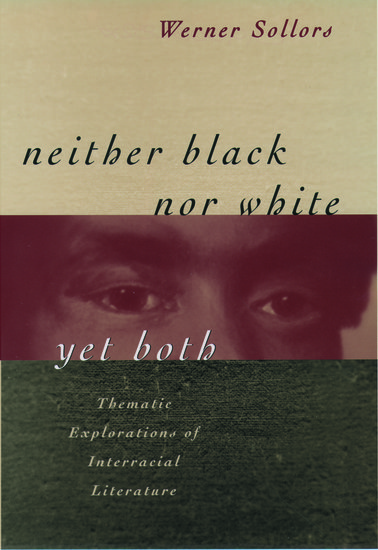Neither Black Nor White Yet Both: Thematic Explorations of Interracial Literature
Oxford University Press
March 1997
592 pages
Hardback ISBN13: 9780195052824; ISBN10: 019505282X
Werner Sollors, Henry B. and Anne M. Cabot Professor of English Literature and Afro American Studies; Director of the History of American Civilization Program
Harvard University

Why can a “white” woman give birth to a “black” baby, while a “black” woman can never give birth to a “white” baby in the United States? What makes racial “passing” so different from social mobility? Why are interracial and incestuous relations often confused or conflated in literature, making “miscegenation” appear as if it were incest? When did the myth that one can tell a person’s race by the moon on their fingernails originate? How did blackness get associated with “the curse of Ham” when the Biblical text makes no reference to skin color at all?
Werner Sollors examines these questions and others in Neither Black Nor White Yet Both, a new and exhaustively researched exploration of “interracial literature.” In the past, interracial texts have been read more for a black-white contrast of “either-or” than for an interracial realm of “neither, nor, both, and in-between.” Intermarriage prohibitions have been legislated throughout the modern period and were still in the law books in the 1980s. Stories of black-white sexual and family relations have thus run against powerful social taboos. Yet much interracial literature has been written, and this book suggests its pervasiveness and offers new comparative and historical contexts for understanding it.
Looking at authors from Heliodorus, John Stedman, Buffon, Thomas Jefferson, Heinrich von Kleist, Victor Hugo, Aleksandr Sergeevic Puskin, and Hans Christian Andersen, to Lydia Maria Child, Harriet Beecher Stowe, William Wells Brown, Mark Twain, Charles Chesnutt, Kate Chopin, Cirilo Villaverde, Aluisio Azevedo, and Pauline Hopkins, and on to modern writers such as Langston Hughes, Jessie Fauset, Boris Vian, and William Faulkner, Sollors ranges across time, space, and cultures, analyzing scientific and legal works as well as poetry, fiction, and the visual arts, to explore the many themes and motifs interwoven throughout interracial literature. From the etymological origins of the term “race” to the cultural sources of the “Tragic Mulatto,” Sollors examines the recurrent images and ideas in this literature of love, family, and other relations between blacks, whites, and those of “mixed race.”
Sollors’ interdisciplinary explorations of literary themes yield many insights into the history and politics of “race,” and illuminate a new understanding of the relations between cultures through the focus on interracial exchanges. Neither Black Nor White Yet Both is vital reading for anyone who seeks to understand what has been written and said about “race,” and where interracial relations can go from here.
Table of Contents
- List of Illustrations
- Introduction:
- Black—White—Both—Neither—In-Between xv
- 1. Origins; or, Paradise Dawning 31
- 2. Natus Æthiopus/Natus Albus 48
- 3. The Curse of Ham; or, from “Generation” to “Race” 78
- 4. The Calculus of Color 112
- 5. The Bluish Tinge in the Halfmoon; or, Fingernails as a Racial Sign 142
- 6. Code Noir and Literature 162
- 7. Retellings: Mercenaries and Abolitionists 188
- 8. Excursus on the “Tragic Mulatto”; or, the Fate of a Stereotype 220
- 9. Passing; or, Sacrificing a Parvenu 246
- 10. Incest and Miscegenation 285
- Endings 336
- Appendix A: A Chronology of Interracial Literature 361
- Appendix B: Prohibitions of Interracial Marriage and Cohabitation 395
- Notes 411
- Selected Bibliography 523
- Index 561